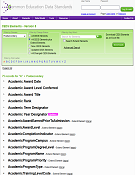Career Pathways Systems
Systems Integration Strategies
The integration strategies provided below have been taken from state efforts around the country that are proving effective in the design, delivery, and diffusion of a better aligned system engaging both career and technical education programs of study and career pathways.
Building comprehensive Career Pathways Systems that include career and technical education programs of study requires the alignment of multiple federal, state, and local programs and a commitment to changes that span multiple state and local agencies and the public and private sectors (including employers in high-demand industry sectors and occupations). To succeed, states and local communities must forge partnerships that bring together a wide range of state/local agencies, employers, community-based organizations, and other system stakeholders to agree upon a common vision and goals for the comprehensive Career Pathways System.
| STRATEGIES |
|---|
Establish a career pathways team that includes state and local leaders from across secondary and postsecondary education (including CTE), adult education, workforce development, human services, economic development, justice, and the private sector, including employers from high demand industry sectors and occupations. |
Conduct service mapping to identify shared goals, services, resources, and performance measures across partner programs. |
Agree upon and clearly define the roles and responsibilities of each partner for the development and implementation of the comprehensive Career Pathways System, formally committing to those roles and responsibilities in a memorandum of understanding (MOU), ensuring that all partners are empowered to make or influence decisions. |
Identify a lead and coordinator at the state and local levels to coordinate day-to-day operations, convene partners, broker opportunities, lead planning, and evaluate the development and progress of the comprehensive Career Pathways System. |
Featured State Example: Minnesota

Adopting a State-Level Infrastructure for Career Pathways Partnerships
To promote their statewide vision, Minnesota has established the Governor’s Workforce Development Council (GWDC).
The GWDC is charged with convening state leaders—drawn from business, education, labor, community organizations, and government—to help develop policies to promote economic growth. In 2015, to formalize the importance of career pathways to the state's continued economic development, the GWDC formed a standing Career Pathways Committee. This committee will continue the work initiated through the state's involvement in the Advancing Career and Technical Education in State and Local Career Pathways Systems project, with a focus on determining what a comprehensive career pathways system looks like in Minnesota and aligning individual education and training programs in the state. By providing an infrastructure for career pathways work within the GWDC, the state has begun to institutionalize the career pathways vision, ensuring ongoing support and leadership for systemic, statewide career pathways development.
Read More
Building Partnerships to Overcome Barriers: Developing Skills to Thrive in a Changing Economy
Download (PDF, 6.8 MB)
Comprehensive Career Pathways Systems must allow students to earn industry-recognized, postsecondary credentials that correspond to the skill needs of employers in high demand industries. In addition, comprehensive Career Pathways Systems must develop shared processes for identifying the skills that are in-demand in the state and in regional economies; determining how students are deemed proficient in these skills; and determining how employers can best validate curriculum and credential alignment.
| STRATEGIES |
|---|
Use multiple dataset labor market analyses, real-time data, and employer advisory groups or partnerships to inform high-demand industry sector identification, as well as curriculum and system design. |
Target high-demand industry sectors for establishment of pathways in the comprehensive Career Pathways System. |
Compare capacity of education and training systems to needs of employers, identify and address skills gaps. |
Identify key employers as partners from the targeted sectors and provide unified outreach. |
Utilize technical skills assessments that
|
Use partnerships with employers to regularly test the validity of technical skills expectations and credentials. |
Incorporate "employability" or "soft" skills into technical skills curricula and instructional strategies. |
Featured State Example: Colorado

Implementing the Colorado Blueprint Through Regional Sector Partnerships
The NoCO Manufacturing Partnership is comprised of a group of more than 50 northern Colorado manufacturing companies and 20 public partners. Working with the state, the group created the Sectors Summit Toolkit which contains resources and tools to support state in replicating project work.
Read More
Program redesign is essential to Career Pathways Systems change and should incorporate elements that promote student success and timely progress to completion, credential attainment, and entry into or progress within careers in high demand occupations. Pathways must be flexible, non-duplicative and accelerated –structured to accommodate the unique needs of youth and adults. Each education level must be carefully articulated to the next, without duplication, with effective academic and career supports and counseling, particularly at points of entry and transition.
| STRATEGIES |
|---|
Ensure course content and curricula
|
Courses (secondary and adult learners)
|
Provide comprehensive academic and career counseling to students at all levels, particularly at the beginning of a POS/CP and at points of transition along the pathway. |
Identify and promote opportunities for secondary students to engage in dual enrollment (high school and postsecondary education courses) and for low-skilled adults to engage in co-enrollment (adult education and postsecondary occupational training)—allowing students to earn college credit while still in high school or in adult education programs, respectively. |
Promote interdisciplinary planning and teaching among academic and CTE teachers and postsecondary technical and basic skills instructors (for low-skilled adults), with the goal of integrated instruction and acceleration. |
Use contextualized content and instructional strategies that teach team building, critical thinking, communication, and other work-readiness competencies. |
Incorporate prior-learning assessments and competency-based education and training models wherever possible, particularly at the postsecondary level. |
Develop career maps that can be used across secondary and postsecondary systems, resulting in credential or degree attainment and in high-demand careers. |
Identify, validate, and keep current technical and workforce readiness skills (using industry-developed or recognized assessments and credentials with value in the labor market, where available, and state-developed assessments and credentials where industry-recognized qualifications do not exist). |
Featured State Example: Oregon

Mapping Pathways Connections: Community College Career Pathways Roadmaps in Oregon
To help high school students learn about their career training options, the state has created an interactive website that enables students to locate community colleges offering career and technical education programs of study that align with their secondary CTE studies. Students may use the site to identify affiliated career areas and programs offered within the college, and to download a career pathway roadmap to assist them in selecting courses.
Read More
Declining federal, state, and local education and training investments, combined with the cross-agency nature of comprehensive Career Pathways System redesign, makes “braided funding” a critical strategy to pay for the costs of student participation, particularly in postsecondary education and training, and for program development and implementation. This approach, paired with efforts to raise additional funding (including alternative financing strategies) and to provide incentives for career pathways development among system stakeholders, will provide a foundation for sustaining and scaling aligned pathways for youth and adults.
| STRATEGIES |
|---|
Identify costs associated with system redesign, development, operations, and costs associated with student participation, particularly at the postsecondary level (e.g., tuition, books). |
Identify areas of overlap, especially between career and technical education programs of study and adult career pathways; explore ways system alignment may lead to efficiencies and savings. |
Conduct unified outreach to raise awareness and build support for comprehensive career pathways among key stakeholder groups including business leaders and policymakers. |
Identify and seek out new funding sources and implement new funding strategies to "braid" multiple funding sources (including local, state, and national public and private initiatives). |
Examine opportunities for alternative financing (e.g., bond financing, augmented FTE, employer-provided training, apprenticeships). |
Jointly develop a sustainability plan. |
Jointly set goals for scaling. |
Featured State Example: Kansas

The Kansas Tuition Assistance and Incentive Program
To promote dual credit opportunities, Kansas established legislation in 2012 to cover the cost of tuition for high school students admitted to a CTE course or program offered within a community college, technical college, or institute of technology. The legislation also directed the State Board of Regents to initiate development of a statewide articulation agreement for CTE programs to support students in transferring their credits earned within high school to a postsecondary institution of their choice.
Read More
Career Technical Education for Secondary Students; Technical College Boards; At-Risk Students; High-Density At-Risk Pupil Weighting; SB 155
Download (PDF, 120 KB)
Each state and local area that is involved in the development of a comprehensive Career Pathways System has a unique set of statutory and administrative policies that affect their ability to align programs and achieve cross-system goals. Similarly, each participating state and local agency sets and/or oversees statutory requirements, rules, regulations, goals, and performance measurement requirements that govern the programs under their jurisdiction. These policies and procedures must be identified, analyzed, and changed when they act as barriers to system alignment and to the development of comprehensive Career Pathways Systems. Similarly, new policies to encourage better alignment and outcomes should be implemented.
| STRATEGIES |
|---|
Conduct a cross-agency policy audit (at the state and local levels) to determine points of alignment across participating programs and agencies, as well as barriers to collaboration. |
Identify policy changes that are needed
|
Teams should examine impediments to systems change
|
Teams should identify and make changes across agencies and institutions
Examples of changes that may be pursued include policies ranging from encouragement for dual and co-enrollment, establishing statewide articulation agreements, increased flexibility for student aid eligibility, and elimination of barriers to cross-system alignment. |
Featured Example: Office of Workforce Investment

Guide to State and Local Workforce Data
The U.S. Employment and Training Administration’s Office of Workforce Investment has released the second edition of its popular Guide to State and Local Workforce Data, which connects users immediately to the information they need.
Read More
To measure the impact of comprehensive Career Pathways Systems, states must find ways to measure cross-system performance and participants' progress beyond what is required for individual program performance accountability and data collection within individual agencies. Cross-system data collection, analysis, and performance measurement should be a priority. Identifying appropriate cross-system outcome measures and holding partner provider systems accountable for making progress based on those measures will require the development of structures and strategies for gathering and sharing quantitative and qualitative data across agencies and partners.
| STRATEGIES |
|---|
Identify system changes and performance indicators, including the participant outcomes that are needed to determine the effectiveness of a comprehensive Career Pathways System that extends from secondary career and technical eduation and adult education to postsecondary credential attainment and employment in high-demand occupations. |
Ensure college and career readiness standards are
|
Align state databases, either through sharing agreements or through incorporation into a P-20 data warehouse, and consider how data will be stored, tracked, and shared. |
Focus on improvements to metrics and data collection methods. |
Set long- and short-term goals; measure progress against them. |
Provide timely data evaluating effectiveness of alignment. |
Ensure data is used to drive decision-making. |
Featured Example: Common Education Data Standards

CEDS 5.0 Includes Career Pathways Data Elements
The National Center for Education Statistics (NCES) has released the Common Education Data Standards (CEDS) 5.0. CEDS is a national collaborative effort to develop voluntary, common data standards for a key set of data elements across the education and workforce pipeline, including data elements with relevance for CTE, adult education, and the workforce. Version 5.0 adds data elements relating to career pathways participation, among other elements.